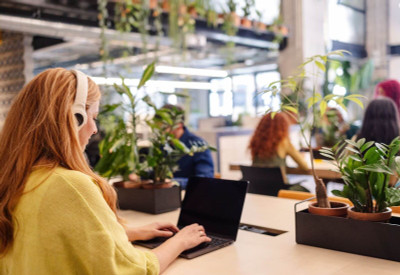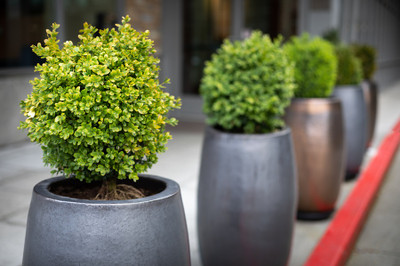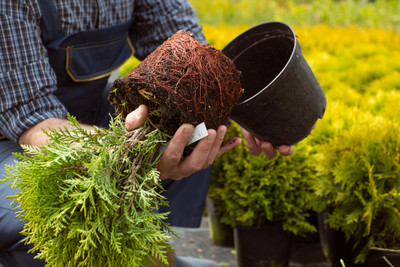When (and How) to Switch Planters: A Complete Guide for Healthy Plants
Posted by Jason Wyrwicz on Nov 25th 2025

Plants never stop growing, and their containers should grow with them. Yet many plant-parents are unsure when to repot indoor plants or worry that switching planters might do more harm than good. The truth is that choosing the right moment to upgrade your pot can make a major difference in your plant’s long-term health.
In this complete guide, you will learn when to repot plants, how to switch planters safely, what size and materials to choose next, and the common mistakes to avoid. By the end, you will feel confident about giving your plant the space it needs to thrive.
When Should You Switch Planters?
Knowing when to repot indoor plants is one of the most important parts of plant care. As roots expand and soil breaks down, your plant eventually outgrows its container. These signs will help you recognise when it is time to repot a plant and give it the extra space it needs.
Visible roots or roots growing through drainage holes
If you notice roots circling the top of the soil, lifting the plant upward, or pushing through the drainage holes, your plant is root-bound. This is one of the clearest answers to when do you repot plants. A tight root system cannot take in water or nutrients efficiently, so moving to a slightly larger pot helps restore healthy growth.
Soil dries out too quickly or water flows straight through
When soil begins to break down, it loses its ability to hold moisture. If you water the plant and the soil dries within hours, or water runs directly through the pot, the roots may not be absorbing enough. This is a strong signal that the pot and soil mix need attention. It often aligns with the general guideline for how often to repot plants, especially for active growers.
Plant looks top-heavy or too large for its pot
A plant that leans, wobbles, or appears much larger than its container has likely outgrown its home. Top-heavy plants are more prone to tipping and may experience stress at the base of their stems. Moving to a pot that is slightly wider provides better stability and gives the roots the space they need. This is a common situation covered when answering how much bigger a pot when repotting plants.
Growth has slowed or leaves are dropping, once other causes are ruled out
Slowed growth, yellowing leaves, or unexplained leaf drop can occur when roots no longer have room to expand. If you have ruled out pests, underwatering, overwatering, and lighting issues, the plant may simply be cramped. At this stage, switching planters allows the roots to stretch and restores normal growth patterns.
Mineral or salt build-up and deteriorating soil
White crust on the soil surface or along the inside of the pot suggests mineral or salt accumulation from fertilizer and tap water. According to The Spruce and UAEX, this build-up can interfere with root health and nutrient uptake. Soil that has become compacted, dusty, or broken down also needs refreshing. In these situations, repotting is often the best solution for improving drainage and overall soil quality.
How Often Should You Consider Switching?
Most houseplants need a new planter every one to three years, while slower-growing varieties may only need repotting every three to five years. There is no single rule for how often to repot plants, because each species grows at its own pace and each home environment affects growth differently. Instead, look at how quickly your plant fills its pot, how the roots behave, and how well the soil holds moisture.
Fast growers such as pothos, philodendrons, spider plants, and monsteras may outgrow their containers much sooner and often show the earliest signs of needing a larger pot. Smaller plants or those that prefer snug root systems may go longer between upgrades. Factors such as pot size, indoor climate, and the plant’s natural growth rate all influence when to repot indoor plants.
If you are unsure when to transplant houseplants, check the roots, water retention, and height-to-pot ratio. These indicators usually give a clearer answer than relying on a strict timeline.
How to Choose The Next Pot (and Size It Correctly)

Choosing the right pot is just as important as knowing when to repot indoor plants. A common mistake is moving to a planter that is far too large. When the pot holds significantly more soil than the plant can use, moisture lingers for too long.
This creates the perfect environment for root rot. The current article on Pots Planters & More also notes that overly large containers stay wet for extended periods, which reduces oxygen flow to the roots and slows growth.
A good rule of thumb is to increase the pot diameter by one to two inches for smaller houseplants. For larger floor plants, you can safely move up by as much as four inches.
Both Pistils Nursery and The Spruce support this guideline, noting that gradual increases prevent waterlogging while still giving roots the space they need. This sizing rule also reflects what most experts advise when people ask how much bigger a pot to use when repotting plants or how much bigger to go when repotting plants.
Material and drainage also matter when deciding on your next planter. Terracotta is breathable and helps prevent overwatering, but it dries out faster and suits plants that prefer lighter moisture levels. Plastic pots retain water longer and are lightweight, making them ideal for fast growers or humid environments.
Ceramic pots offer stability and style but should always include drainage holes. If your preferred decorative container is a cache-pot without holes, place a well-draining nursery pot inside it so you can lift the plant out for watering.
Style plays a role too. As you upgrade, choose a planter that fits your décor and matches the plant’s projected size. Tall plants often look best in simple, clean-lined pots, while trailing plants pair well with rounded silhouettes or elevated stands. Considering the plant’s future shape helps prevent mismatches in proportion or overcrowding as it grows.
There are also times when you do not need to switch pots at all. Slow-growing houseplants can remain in the same container for several years with no issue. If you enjoy the shape and size of the current pot, you can simply refresh the soil instead.
Step-by-Step: How to Switch Your Planter Safely
Switching planters is simple once you understand the proper order of steps. Following a clear process protects the roots, reduces transplant shock, and helps you answer common questions, such as: Should I water after repotting, and how long after repotting should I water?
Use this guide to repot confidently and keep your plant growing strong.
1. Choose the right timing
The best time to repot is during spring or the early growing season when the plant is naturally pushing out new roots. According to the Old Farmer’s Almanac, plants handle repotting better when they are actively growing rather than dormant.
2. Gather your supplies
Prepare everything you need before removing the plant from its pot. This includes a new planter, fresh potting mix, gloves, a trowel, and optional items such as fertilizer or small pruning shears for root trimming. Having everything ready makes the process smooth and reduces stress on the plant.
3. Remove the plant carefully
Gently loosen the soil around the inside of the pot. Tilt the pot on its side and ease the plant out while supporting the base. Avoid pulling directly on the stems. Once removed, examine the root ball to understand how tightly it has filled the container.
4. Inspect and manage the roots
Look for circling or tangled roots, as these can restrict growth. Loosen the root ball with your fingers and trim any dead, mushy, or excessively long roots. This step improves nutrient absorption and helps the plant adjust to its new container.
5. Prepare the new pot
Check that the pot has proper drainage. If necessary, clean the drainage holes or add a thin layer of gravel to prevent clogging. Add fresh soil to create a base layer that positions the plant at the correct height. The goal is to keep the plant at the same soil level as before.
6. Set the plant in place
Position the plant in the center of the new pot. Fill soil around the sides, gently pressing to remove air pockets, but avoid packing it too tightly. Leave a small amount of space at the top to make watering easier and prevent overflow.
7. Water thoroughly
After repotting, water the plant until moisture flows out of the drainage holes. This helps settle the soil around the roots. Place the plant back in its normal light conditions and monitor it for the next few weeks. This step also helps clarify how long after repotting to water, since the first watering should happen immediately.
8. Provide gentle after-care
Hold off on heavy fertilizing for a few weeks, since fresh soil already contains nutrients. Adjust your watering routine because new soil usually holds moisture differently. During this period, watch for signs of stress, such as drooping leaves, and give the plant time to adjust.
Mistakes to Avoid
Repotting is simple, but a few common mistakes can cause stress, root damage, or long-term growth problems. Understanding what to avoid will help you repot confidently and support healthier plants. Here’s what to look out for:
- Choosing a pot that is too large: Moving to a pot much bigger than needed often leads to soggy soil and a high risk of root rot. This is one of the most common repotting errors.
- Skipping drainage or using outdoor soil: Planters without drainage trap water around the roots. Outdoor soil compacts too easily and prevents airflow, making it unsuitable for indoor plants.
- Repotting at the wrong time: Avoid repotting when a plant is dormant, stressed, or recovering from pests. The best time to repot plants is during active growth.
- Ignoring root-bound plants or repotting unnecessarily: Some plants decline if left root-bound for too long, while others prefer snug conditions. Repot when signs are present rather than on a strict schedule.
- Reusing old, compacted soil: Soil breaks down over time and loses nutrients. Always refresh the mix or replace it entirely when repotting.
- Choosing a pot only for appearance: A planter should match your décor, but it must also meet the plant’s needs. Consider drainage, size, and material before style.
Style and Alternative Options
Before you switch pots, it helps to look at a few style choices that keep your space fresh without constant upsizing. Here are a few simple ideas you can use:
- After upsizing, you can still keep a planter you love in use by moving a smaller or slow-growing plant into it. This lets your bigger plant move on while keeping your favourite container in your space.
- Choose slow-growing plants like ZZ plants, snake plants, and certain succulents if you want fewer repotting sessions and a steady, low-maintenance look.
- Consider aesthetics as you plan your setup. You can group planters of the same design in different heights or mix terracotta, ceramic, and metal for more depth. Pick shapes and finishes that blend well with your furniture and colour choices.
- Outdoor and indoor planters serve different roles. Outdoor pots face weather shifts, so fiberglass, heavy ceramic, and concrete stay durable and stable. They also need strong drainage and winter prep. Indoor pots can lean more toward style as long as they drain well and suit the plant’s needs.
Special Cases and FAQs
Some plants do not follow the usual repotting rules. These special cases help clarify when to repot indoor plants, when to avoid upsizing, and what to do if a plant needs different care than expected.
Succulents and cacti
Succulents and cacti prefer tighter root space and often grow best when slightly root-bound. Using a pot that is too large increases the risk of trapped moisture and rot, since these plants need fast-draining soil and controlled watering. Only upsize when roots clearly fill the pot or the plant becomes unstable.
Fast growers (large floor plants)
Plants like monsteras, fiddle leaf figs, and dracaenas can outgrow their containers quickly. These fast growers often need more frequent upgrades, especially when their roots reach the drainage holes or the soil dries extremely fast. For these species, how often to repot plants depends heavily on growth speed and room size.
Plants in decorative cache-pots
Many people place nursery pots inside decorative cache-pots. This is perfectly fine as long as the inner pot has drainage holes. If the cache-pot has no drainage, remove the plant to water it, allow the excess to drain, and place it back once the soil stops dripping. This prevents hidden water accumulation around the roots.
Refreshing soil without upsizing
If you only want to refresh the soil, gently lift the plant from its pot, loosen the outer layer of old soil, and replace it with fresh mix. This is helpful for slow growers, plants that prefer snug conditions, or situations where the current pot suits your décor. It improves root health without committing to a larger container.
When a plant might need a smaller pot
Although rare, a plant may occasionally benefit from a slightly smaller pot. This happens when the plant is placed in a pot that was too large to begin with, causing the soil to stay wet for too long. Signs include persistent moisture, yellowing leaves, and slow growth despite otherwise healthy conditions. In this case, downsizing to a tighter pot helps restore proper moisture balance.
Give Your Plant the Space It Deserves
Knowing when to repot indoor plants becomes much easier once you understand the signs. With the right approach, switching planters becomes a simple part of helping your plants thrive.
Quick Yes or No Checklist: Is It Time to Switch Planters?
Here is a quick yes-or-no check you can use:
Are roots visible on top or coming through drainage holes?
☐ Yes → Time to repot
☐ No → Move to the next question
Does water run straight through or does the soil dry out too fast?
☐ Yes → Soil is depleted or the pot is too small
☐ No → Continue checking
Is the plant top-heavy, leaning, or outsizing the pot?
☐ Yes → Needs a larger container
☐ No → Next question
Has growth slowed or are leaves dropping for no clear reason?
☐ Yes → Repotting may help
☐ No → Keep observing
Is there mineral or salt build-up, or old compacted soil?
☐ Yes → Refresh soil or repot
☐ No → Repotting may not be needed
If most answers lean toward Yes, your plant is due for a new home.
To find a pot that fits your space and gives your plant room to grow, browse our range of indoor planters for fresh ideas.



